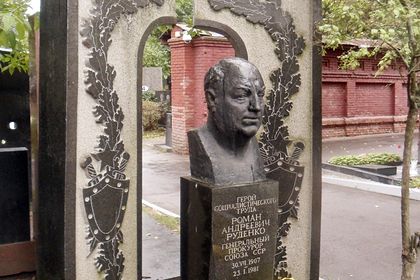In Novosibirsk, they wanted to install a bust of Prosecutor General Rudenko, who was a member of the NKVD troika 
In Novosibirsk, they wanted to install a bust of the Prosecutor General, the entrance of the USSR, Roman Rudenko Joseph Stalin as a member of the special troika of the NKVD and who signed the protocols on the executions. Such a proposal was made by the regional prosecutor's office, Tatyana Ivanenko, head of the Siberian Center for the Promotion of Architecture, wrote on Facebook.
The initiative group intended to install a bust near the building of the Siberian Institute of Management of the RANEPA on Nizhegorodskaya Street. The Novosibirsk prosecutor's office made its information about Rudenko extremely brief. According to Ivanenko, there was no information in it that in 1937-38 the Prosecutor General was a member of the special troika of the NKVD, and in the 70s he prepared documents for the Politburo of the CPSU Central Committee on the persecution of dissidents.
The director of the Siberian Center for the Promotion of Architecture noted that the initiative was not supported due to “insufficient materials for making an informed decision.”
“I was struck by the short but capacious speech of the deputy of the Council of Deputies of Novosibirsk. He called the repressions measures that were carried out with the aim of “protecting the purity of the nation,” – said Ivanenko.
Roman Rudenko was part of the troika in the Donetsk region of the Ukrainian SSR. His surname is present in the order of the NKVD dated July 30, 1937, which launched repressions against “former kulaks, criminals and other anti-Soviet elements.”
Special NKVD troikas worked from September to November 1938. They consisted of the head of the NKVD, the secretary of the regional committee and the prosecutor of the region, who received the right to sentence those arrested to death, imprisonment in camps or prisons for a term of eight to ten years. The minutes of their meetings became one of the sources of information about the number of victims of the Soviet political repressions of 1937-1938.
In two months, special troikas went through the cases of about 108 thousand people arrested before August 1, 1938. Almost 70 percent of people were sentenced to death.
Most of the members of the triplets were also repressed until November 1938, that is, they were sentenced to the same triplets, of which they were earlier. When liquidating these bodies, the authorities of the USSR noted gross violations of procedural rules – in particular, falsifications, forgeries, conviction of innocent people. In 1989, by a decree of the Presidium of the Supreme Soviet of the USSR, the troikas were declared unconstitutional, and their court decisions were canceled.